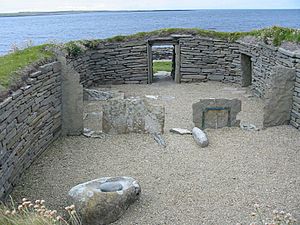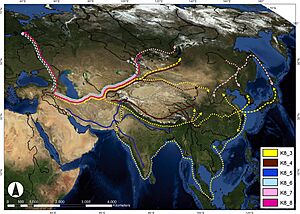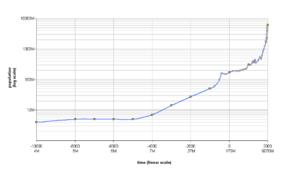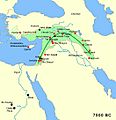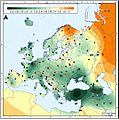Neolithic revolution facts for kids
The Neolithic Revolution was a huge change in how people lived. It was the first time humans really started farming. Before this, people were mostly nomads, meaning they moved around a lot. They survived by hunting animals and gathering wild plants.
But during the Neolithic Revolution, people slowly started to grow their own food and raise animals. This meant they could stay in one place. A smart person named Vere Gordon Childe came up with the name "Neolithic Revolution" in the 1920s. He thought it was as important as the Industrial Revolution, which happened much later.
This big change involved people learning early farming methods. They started growing crops and taming wild animals, a process called domestication. Scientists have found proof that different plants and animals were tamed in many parts of the world. This began about 11,700 years ago, after the last Ice Age ended. It was the first time humans truly switched to farming.
The Neolithic Revolution was super important for how societies were set up and for new technology. It led to people living in permanent homes instead of always moving. Because of this, fewer people lived a nomadic life. People also started to think about who owned land, especially to know whose crops were whose.
The way people lived changed the natural environment. More people could live in one area, so populations grew. People also ate more vegetables and cereals in their diet. New social structures, like hierarchies, began to form. People could store extra grain, which they could trade. Having extra food from good crops helped communities survive when harvests were bad.
Contents
Taming Animals and Growing Food

When humans learned to choose and breed certain plants, like emmer, einkorn, and barley, and tame animals like dogs, goats, sheep, and cattle, human society changed a lot.
Because people now grew crops and raised livestock, they didn't need to move around anymore. They could build better settlements and stay in one place. Their diet also changed, including more grains and vegetables. One of the most important crops, barley, was first tamed in the Near East about 11,000 years ago. Barley is a tough plant that can grow in many different places, even in high or cold areas. Evidence shows that barley had spread across Europe and Asia by 2,000 BC.
Early farmers got better at farming techniques, like irrigation (watering crops). This meant they had extra food, called a surplus, which they needed to store. People who hunted and gathered couldn't easily store food because they moved so much. But settled farmers could store their extra grain. Over time, they built granaries to keep their seeds safe for longer. With more food, the population grew, and communities developed special workers and better tools.
When people stopped hunting and gathering and started producing food, it made sense to keep animals nearby. So, they began bringing animals permanently to their homes. They chose animals based on their size, behavior, diet, how they mated, and how long they lived. Animals that gave milk, like cows and goats, were very valuable because they provided a constant source of protein. Animals that could work, like pulling plows, were also important. Besides food, animals provided leather, wool, hides, and fertilizer for crops. Some of the first animals tamed were dogs (about 15,000 years ago), sheep, goats, cows, and pigs.
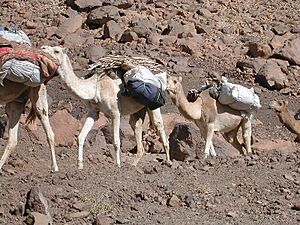
West Asia was a key place for taming many animals, including sheep, goats, and pigs. It was also the first place to tame the dromedary (a type of camel).
These big changes happened in different parts of the world on their own. But they didn't always happen in the same order. For example, the first farming groups in the Near East didn't use pottery. And in early Japan, people used pottery before they started farming.
In the Paleolithic era, there were many different types of humans. But according to what we know now, only modern humans reached the Neolithic period.
Scientists have used genetic studies to understand how barley farming spread. They found that barley moved across Europe and Asia in several different ways, likely at different times and in different places.
Ideas About Why It Happened
There are several ideas about why humans started farming:
- Oasis theory: This idea suggests that the climate became drier. So, early humans, animals, and plants gathered near oases (places with water in the desert) to survive. It was then easy to start taming the animals and plants found there. However, climate data from that time doesn't really support this idea.
- Hilly Flanks theory: This idea says that farming began in the hilly areas of the Taurus and Zagros mountains. It suggests that people living there started gathering a lot of wild grains, which slowly led to farming.
- Feasting model: This idea suggests that farming started because people wanted to show off their power. They would throw big parties, called feasts, which needed a lot of food. This need for food pushed them to develop farming methods.
- Population theories: These ideas say that the local population grew so much that hunting and gathering couldn't feed everyone. More food was needed than could be found in the wild. Different social and economic reasons also made people need more food.
- Evolutionary/intentionality theory: This idea suggests that farming was a natural step in how plants and humans evolved together. People started by protecting wild plants. Then they chose better places to grow them. Finally, they fully tamed them.
Why It Was Important
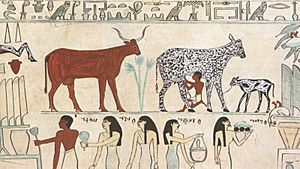
The Neolithic Revolution brought big changes to human life. Here are some of the main reasons it happened:
- New beliefs: Some think that people started taming animals for religious reasons. Their beliefs changed, and symbols like Venus figurines might show this.
- Crowding and stress: Many animals died out at the end of the last Ice Age. The human population had grown and filled up all the available land. There wasn't enough food. Farming became the only way to feed everyone.
- Discoveries by gatherers: People who gathered food, often women, cared for the young and kept fires going. Over time, they learned which plants were safe to eat or could help with illnesses. They also helped tame animals that then traveled with humans.
How Life Changed
Social Changes
Even though farming brought new tools and knowledge, the world's population didn't grow super fast right away. The good things about farming were balanced by some bad things, like more diseases and wars.
Farming didn't always mean life got better for everyone. The food that Neolithic farmers ate was often not as good for them as what hunter-gatherers ate. Studies show that switching to diets based on grains led to people being shorter and not living as long. There were more baby deaths and more illnesses. People also got more long-term diseases like obesity and diabetes, and they had problems with their bones and teeth. For example, the average height for Europeans went down quite a bit and didn't return to pre-farming levels until the 20th century.
The common idea is that farming allowed more people to live in one place. This led to bigger communities, where people could collect more goods and tools. It also meant people could specialize in different jobs. Having extra food allowed some people to become leaders who didn't have to farm. They made decisions for the community. But bigger societies also meant people could try different ways of making decisions and governing themselves.
A historian named Andrew Sherratt talked about a "secondary products revolution" after the Neolithic Revolution. At first, animals were mainly tamed for meat. But the secondary products revolution happened when people realized animals could provide many other useful things. These included:
- Hides and skins (from both wild and tamed animals)
- Manure (animal waste) for making soil better
- Wool (from sheep, llamas, alpacas, and Angora goats)
- Milk (from goats, cattle, yaks, sheep, horses, and camels)
- Traction (animals pulling things, like oxen, donkeys, horses, and camels)
- Guarding and herding help (dogs)
Sherratt believed this stage of farming allowed humans to use animal energy in new ways. It made it possible to farm intensely and grow crops in tougher soils. It also led to nomadic pastoralism, where people moved with their herds in dry areas, and eventually to taming the dromedary and Bactrian camel. However, too much grazing, especially by goats, also caused deserts to grow bigger.
Diet and Health
Compared to hunter-gatherers, Neolithic farmers ate more carbohydrates but less fiber, micronutrients, and protein. This led to more cavities and slower growth in children. Studies consistently show that people around the world became shorter after they started farming. This might have been worse because farming diets depended more on seasons, and there was a higher risk of famine if crops failed.
As people started living in settled communities, diseases spread faster than they did when people were hunter-gatherers. Poor hygiene and living close to tamed animals might explain why more people got sick and died after the Neolithic Revolution. Diseases could jump from animals to humans. Some examples of infectious diseases that spread from animals to humans include influenza, smallpox, and measles.
Over time, through a process called natural selection, humans who first tamed large mammals built up defenses against these diseases. Each generation, people with better defenses were more likely to survive. After about 10,000 years of living near animals like cows, people in Europe and Africa became more resistant to these diseases. This is why when Europeans came to places like the Caribbean and the Americas, many local populations were wiped out by diseases they had never encountered. For example, 90% or more of many populations in the Americas died from European and African diseases before they even met European explorers. Some cultures, like the Inca Empire, had a large tamed animal, the llama, but llama milk wasn't drunk, and llamas didn't live in close quarters with humans, so the risk of disease spreading was lower.
Images for kids
-
How temperatures changed after the Last Glacial Maximum (LGM) according to Greenland ice cores. Farming began when temperatures rose quickly at the end of the cold Younger Dryas period and the start of the warm Holocene period.
-
The Neolithic era is known for fixed human settlements and the invention of agriculture from about 10,000 years ago. This is a reconstruction of a Pre-Pottery Neolithic B house in Aşıklı Höyük, modern Turkey.
-
Ancient European Neolithic farmers were genetically most similar to modern people from the Near East and Anatolia. This map shows genetic distances between European Neolithic Linear Pottery Culture populations (5,500–4,900 years ago) and modern Western Eurasian populations.
-
Possible places where language families began, and how early rice farming likely spread (around 3,500 to 500 BCE). The lighter blue shows the approximate coastlines during the early Holocene.
See also
 In Spanish: Revolución neolítica para niños
In Spanish: Revolución neolítica para niños


